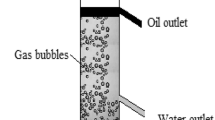Abstract
The objective of this paper is to study the effect of amphoteric surfactant at different operating conditions concerning the oil–water separation from Dulang Oil field by using a laboratory-scale flotation column. A model has been developed to optimize the flotation process by using response surface method (RSM). The produced water containing surfactant was created by mixing the Dulang crude oil with the initial concentration of 1000 ppm, brines at 14000 ppm concentration, and MFOMAX amphoteric surfactant ranging from 0 to 500 ppm. A total of 32 experiments were conducted, and the effect of gas flowrate, MFOMAX concentration, and duration of flotation on the efficiency of oil removal from the flotation units has been analyzed. The experimental data results were then statistically analyzed, and the experiments were conducted for verification. The experimental results were found in fair agreement with the model’s predicted value, suggesting that the model could define the relationship between parameters. With the presence of MFOMAX, the optimal combination of parameters was at 4 L/min gas flowrate at the duration of 9 min with the efficiency of 87.3%. Confirmatory experiments were conducted at the optimum parameters to verify the model. The experimental value of 82.8% (STD 1.60) was obtained which indicated a good agreement with the predicted results.
Copyright 2018, Shaanxi Petroleum Society.
This paper was prepared for presentation at the 2018 International Field Exploration and Development Conference in Xi’an, China, 18–20 September, 2018.
This paper was selected for presentation by the IFEDC Committee following review of information contained in an abstract submitted by the author(s). Contents of the paper, as presented, have not been reviewed by the IFEDC Committee and are subject to correction by the author(s). The material does not necessarily reflect any position of the IFEDC Committee, its members. Papers presented at the Conference are subject to publication review by Professional Committee of Petroleum Engineering of Shaanxi Petroleum Society. Electronic reproduction, distribution, or storage of any part of this paper for commercial purposes without the written consent of Shaanxi Petroleum Society is prohibited. Permission to reproduce in print is restricted to an abstract of not more than 300 words; illustrations may not be copied. The abstract must contain conspicuous acknowledgment of IFEDC. Contact email: paper@ifedc.org.
Access this chapter
Tax calculation will be finalised at checkout
Purchases are for personal use only
Similar content being viewed by others
References
Liu S, Zhao X, Dong X, Du W, Miao B. Treatment of produced water from polymer flooding process using a new type of air sparged hydrocyclone. In: Proceedings of SPE Asia Pacific Health, safety and environment conference and exhibition; 2005.
Wang B, et al. The effects of oil displacement agents on the stability of water produced from ASP (alkaline/surfactant/polymer) flooding. Colloids Surf, A. 2011;379(1–3):121–6.
Hirasaki GJ, Miller CA, Raney OG, Poindexter MK, Nguyen DT, Hera J. Separation of produced emulsions from surfactant enhanced oil recovery processes. Energy Fuels. 2011;25(2):555–61.
Qi WK, Yu ZC, Liu YY, Li YY. Removal of emulsion oil from oilfield ASP wastewater by internal circulation flotation and kinetic models. Chem Eng Sci. 2013;91:122–9.
Zhang F, Wang F, Ouyang J, Zhang H. The development and application of a demulsifier used for ASP flooding-produced liquid from the Xing 2 area of the Daqing Oilfield. Pet Sci Technol. 2011;29(1):69–78.
Eftekhardadkhah M, Aanesen SV, Rabe K, Øye G. Oil removal from produced water during laboratory- and pilot-scale gas flotation: the influence of interfacial adsorption and induction times. Energy Fuels. 2015;29(11):7734–40.
Strickland WT. Laboratory results of cleaning produced water by gas flotation. Soc Pet Eng J. 1980:175–90.
Dalmazzone C, Noïk C, Argillier J-FF. Impact of chemical enhanced oil recovery on the separation of diluted heavy oil emulsions. Energy Fuels. 2012;26(6):3462–9.
Multon LM, Viraraghavan T. Removal of oil from produced water by dissolved air flotation. Pract Period Hazard, Toxic, Radioact Waste Manag. 2008;12(1):25–9.
Moosai R, Dawe RA. Oily wastewater cleanup by gas flotation. West Indian J Eng. 2002;25(1):25–41.
Frankiewicz T, Lee C, Juniel K. Compact induced gas flotation as an effective water treatment technology on deep water platforms. Offshore technology conference; 2005.
Xing Y, et al. Recent experimental advances for understanding bubble-particle attachment in flotation. Adv Coll Interface Sci. 2017;246:105–32.
Ran J, Liu J, Zhang C, Wang D, Li X. Experimental investigation and modeling of flotation column for treatment of oily wastewater. Int J Min Sci Technol. 2013;23(5):665–8.
Acknowledgements
A special thanks to PETRONAS Research Sdn. Bhd, Malaysia, for providing the Dulang crude oil and MFOMAX samples to Centre of Enhanced Oil Recovery (COREOR), Petroleum Engineering, Universiti Teknologi PETRONAS, Malaysia.
Author information
Authors and Affiliations
Corresponding author
Editor information
Editors and Affiliations
Rights and permissions
Copyright information
© 2020 Springer Nature Singapore Pte Ltd.
About this paper
Cite this paper
Ishak, K.E.H.K., Ayoub, M.A. (2020). The Oil and Water Separation from Surfactant Produced Water by Using a Flotation Column. In: Lin, J. (eds) Proceedings of the International Field Exploration and Development Conference 2018. IFEDC 2018. Springer Series in Geomechanics and Geoengineering. Springer, Singapore. https://doi.org/10.1007/978-981-13-7127-1_58
Download citation
DOI: https://doi.org/10.1007/978-981-13-7127-1_58
Published:
Publisher Name: Springer, Singapore
Print ISBN: 978-981-13-7126-4
Online ISBN: 978-981-13-7127-1
eBook Packages: EngineeringEngineering (R0)




